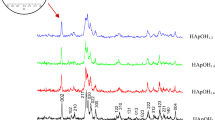Abstract
Hydroxyapatite (HA) is an important material for biomedical implants, because its chemical composition is similar to that of bone tissue. This study focuses on the effect of sintering temperature and the amount of reinforcement phase on the mechanical properties of HA–Ti composites. Firstly, the production of hydroxyapatite powders that are consistent with the natural bone tissue was planned by means of chemical precipitation method. Secondly, the titanium element was added into this hydroxyapatite powder mixture by different amounts to investigate the change of mechanical properties. Titanium isopropoxide, Ti(OCH(CH3)2)4, was used as titanium supplier. These were solved and added into calcium solution without phosphate solution addition. In total, 0.5, 1, 2 and 4 mol% Ti were added into pure hydroxyapatite obtained by chemical precipitation method. The powders including different amounts of Ti additions were dried after the precipitation process and exposed to calcination at different temperatures in order to detect the phases obtained during the process. Microstructures have been investigated by SEM and EDS, and the phase analysis has been determined by the X-ray diffraction analysis, FTIR, DTA-TG and Raman spectrometers. The grain size and apparent density were measured. These results showed that titanium could enter into HA.











Similar content being viewed by others
References
Soballe K. Hydroxyapatite ceramic coating for bone implant fixation. Mechanical and histological studies in dogs. Acta Orthop Scand Suppl. 1993;1:58.
Albers CE, Hofstetter W, Siebenrock KA, Landmann R, Klenke FM. In vitro cytotoxicity of silver nanoparticles on osteoblasts and osteoclasts at antibacterial concentrations. Nanotoxicology. 2013;7:30–6.
Yajing Y, Xuejiao Z, Caixia L, Yong H, Qiongqiong D, Xiaofeng P. Preparation and characterization of chitosan-silver/hydroxyapatite composite coatings on TiO2 nanotube for biomedical applications. Appl Surf Sci. 2015;332:62–9.
Huang J, Best SM, Bonfield W, Buckland T. Development and characterization of titanium-containing hydroxyapatite for medical applications. Acta Biomater. 2010;6:241–9.
Niespodzianaa K, Jurczyk K, Jakubowicz J. Fabrication and properties of titanium–hydroxyapatite nanocomposites. Mater Chem Phys. 2010;123:160–5.
Mohan L, Durgalakshmi D, Geetha M, Sankara Narayanan TSN, Asokamani R. Electrophoretic deposition of nanocomposite (HAp + TiO2) on titanium alloy for biomedical applications. Ceram Int. 2012;38:3435–43.
Chang Q, Ru HQ, Chen DL, Zhang CP, Yang JL, Hu SL. Interfacial reactions in Ti–Fe particles reinforced hydroxyapatite matrix composites. Mater Lett. 2014;128:245–7.
Farnousha H, Muhaffel F, Cimenoglu H. Fabrication and characterization of nano-HA-45S5 bioglass composite coatings on calcium-phosphate containing micro-arc oxidized CP-Ti substrate. Appl Surf Sci. 2015;324:765–74.
Bovand D, Yousefpour M, Rasouli S, Bagherifard S, Bovand N, Tamayol A. Characterization of Ti–HA composite fabricated by mechanical alloying. Mater Des. 2015;65:447–53.
Ribeiro Cristina C, Gibsond I, Barbosa A, Ribeiro Cristina C, Gibsond I, Barbosa A. The uptake of titanium ions by hydroxyapatite particles—structural changes and possible mechanisms. Biomaterials. 2006;27:1749–61.
Kim SR, Kim YH, Riu DH, Jung SJ, Lee YJ. Synthesis and characterization of Ti-substituted hydroxyapatite. Key Eng Mater. 2003;240–243:501–4.
Chen HT, Shu HY, Chung CJ, He JL. Assessment of bone morphogenic protein and hydroxyapatite–titanium dioxide composites for bone implant materials. Surf Coat Technol. 2015;276:168–74.
Petkova V, Koleva V, Kostova B, Sarov S. Structural and thermal transformations on high energy milling of natural apatite. J Therm Anal Calorim. 2015;121:217–25.
Ergun C. Effect of Ti ion substitution on the structure of hydroxylapatite. J Eur Ceram Soc. 2008;28(2137):2149.
Berezhnaya A, Mittova V, Kostyuchenko A, Mittova I. Effect of high-temperature annealing on solid-state reactions in hydroxyapatite/TiO2 films on titanium substrates. Inorg Mater. 2008;44:1214–7.
Arifin A, Sulong AB, Muhamad N, Syarif J, Ramali MI. Material processing of hydroxyapatite and titanium alloy (HA/Ti) composite as implant materials using powder metallurgy. Mater Des. 2014;55:165–75.
Ye H, Liu X, Hong H. Characterization of sintered titanium/hydroxyapatite biocomposite using FTIR spectroscopy. J Mater Sci Mater Med. 2009;20:843–50.
Chu C, Lin P, Dong Y, Xue X, Zhu J, Yin Z. Fabrication and characterization of hydroxyapatite reinforced with 20 vol% Ti particles for use as hard tissue replacement. J Mater Sci Mater Med. 2002;13:985–92.
Lu YP, Li MS, Li ST, Wang ZG, Zhu RF. In vitro bioactive nano-crystalline TiO2 layers grown at glass-coating/titanium interface. Biomaterials. 2004;25:4393–403.
Nelea V, Morosanu C, Bercu M, Mihailescu IN. Interfacial titanium oxide between hydroxyapatite and TiAlFe substrate. J Mater Sci Mater Med. 2007;18:2347–54.
Pan HB, Li ZY, Lam WM, Wong JC, Darvell BW, Luk KDK. Solubility of strontium-substituted apatite by solid titration. Acta Biomater. 2009;5:1678–85.
Enayati-Jazi M, Solati-Hashjin M, Nemati A, Bakhshi F. Synthesis and characterization of hydroxyapatite/titania nanocomposites using in situ precipitation technique. Superlattices Microstruct. 2012;51:877–85.
Author information
Authors and Affiliations
Corresponding author
Rights and permissions
About this article
Cite this article
Özbek, Y.Y., Erdem Baştan, F., Canikoğlu, N. et al. The experimental study of titanium-ions into hydroxyapatite by chemical precipitation. J Therm Anal Calorim 125, 651–658 (2016). https://doi.org/10.1007/s10973-016-5335-8
Received:
Accepted:
Published:
Issue Date:
DOI: https://doi.org/10.1007/s10973-016-5335-8




